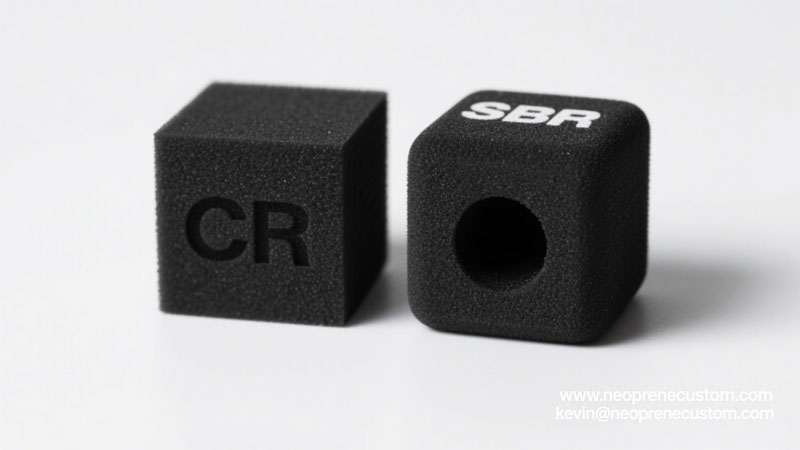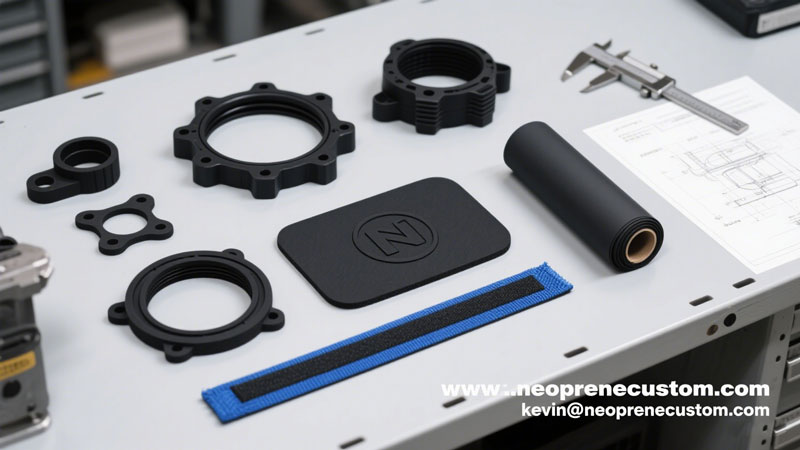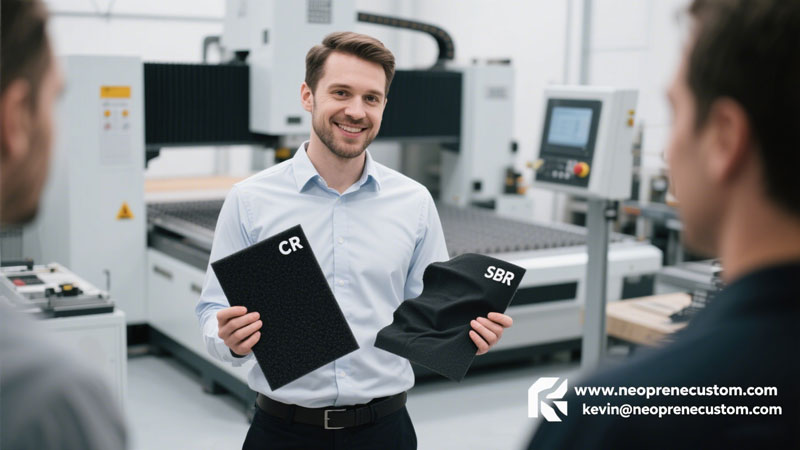Are You Tired of Products That Lose Their Shape and Fail Under Pressure? Have You Ever Questioned What Makes a Material Truly Durable?
In the world of product design and manufacturing, haven't you often faced the challenge of selecting a material that promises longevity? You specify a foam component, a gasket, a seal, or a cushion, expecting it to perform flawlessly for years. But what happens when that component flattens, deforms, and fails to bounce back, compromising the integrity of your entire product? This failure, this permanent deformation under stress, is what engineers call "compression set." Isn't it one of the most critical yet frequently overlooked properties when specifying flexible materials?
When it comes to versatile elastomers, neoprene foam is often the go-to choice. But did you know that not all "neoprene" is created equal? The term is often used loosely to describe materials that look and feel similar but possess vastly different chemical backbones and, consequently, performance characteristics. The most common variants you'll encounter are CR (Chloroprene), which is true neoprene, and SBR (Styrene-Butadiene Rubber), a more economical synthetic rubber often blended or sold as a neoprene alternative.
So, the crucial question for any designer, engineer, or product manager is this: When your product's reputation and long-term performance are on the line, how do you choose between CR and SBR foams, especially concerning compression set? And more importantly, how do you find a manufacturing partner who not only understands these nuances but can also deliver a perfectly customized component tailored to your exact needs?
This is where we, as specialist manufacturers of custom neoprene products, step in. We believe an informed client is our best partner. Let's delve deep into the science of compression set and demystify the CR vs. SBR debate. Aren't you ready to make a choice that guarantees performance?

What Exactly Is This "Compression Set" We're Talking About?
Imagine pressing your thumb into a piece of foam. When you lift your thumb, does the foam spring back instantly and completely, or does it leave a lingering indentation? That indentation is a visual representation of compression set. Can you see how critical this is?
Formally, compression set, often measured according to standards like ASTM D395, is the percentage of original deflection that a material fails to recover after a sustained compressive force is removed. A lower percentage is always better. A foam with a 5% compression set is far superior to one with a 50% compression set. Why? Because the 50% set material has permanently lost half of its ability to seal, cushion, or support. It has failed.
Think about it in real-world applications.
Could a car door seal with high compression set effectively keep out water and wind after a year of being compressed?
Would an orthopedic knee brace provide consistent support if its foam padding flattens after just a few weeks of wear?
Can an industrial gasket maintain a high-pressure seal if it permanently deforms under operational heat and load?
The answer to all these questions is a resounding no. So, isn't it clear that understanding and specifying for low compression set is fundamental to creating a quality, long-lasting product?
The Contenders: A Closer Look at CR (Chloroprene) and SBR (Styrene-Butadiene Rubber)
Now that we've established the enemy—high compression set—let's meet our two main contenders. On the surface, a sheet of CR foam and a sheet of SBR foam might look identical. They are both black, flexible, and soft. But their performance under pressure couldn't be more different. What lies within their molecular structure that creates this chasm in performance?
1. CR (Chloroprene Rubber): The High-Performance Champion
Isn't it telling that CR is what scientists first synthesized and named "neoprene"? It is the original, the benchmark. CR is a polymer of chloroprene, and its molecular structure is packed with chlorine atoms. Why does this matter?
The presence of chlorine gives CR an inherently stable and robust chemical structure. This results in a material with a fantastic balance of properties:
Excellent Resistance to Oils and Chemicals: It can withstand exposure that would degrade lesser rubbers.
Superb Weather, Ozone, and UV Resistance: This makes it ideal for outdoor and automotive applications.
A Wide Operational Temperature Range: It remains flexible and functional in both hot and cold environments.
But most importantly for our discussion, CR exhibits an exceptionally low compression set. Its strong, cross-linked polymer chains are resilient. They resist being permanently knocked out of place when compressed, even for long durations and at elevated temperatures. They have a powerful "memory," always seeking to return to their original shape.
When you require a seal that must remain tight for a decade, padding that must provide consistent cushioning day after day, or a component that faces constant dynamic loads, isn't CR the obvious and superior choice? Its ability to resist permanent deformation is what defines its premium status.

2. SBR (Styrene-Butadiene Rubber): The Economical Generalist
So, if CR is so great, why does SBR even exist? The answer, as is often the case in manufacturing, comes down to cost. SBR is a copolymer of styrene and butadiene. It is one of the most widely produced synthetic rubbers in the world, primarily because it's inexpensive to manufacture.
SBR offers some decent physical properties:
Good Abrasion Resistance: It's tough and can handle wear and tear.
High Tensile Strength: It's strong and resists being pulled apart.
However, where does it fall short? Its molecular structure lacks the inherent stability of CR. This leads to several critical compromises:
Poor Resistance to Oils, Solvents, and Ozone: It will swell, weaken, and crack when exposed to these elements.
A More Limited Temperature Range: It can become brittle in the cold and soft in the heat.
And here is the crucial point: SBR has a significantly higher compression set compared to CR. Its polymer chains are more susceptible to permanent rearrangement under load. When you compress SBR foam, especially over time or with a bit of heat, it is far more likely to stay compressed. The "memory" is weaker.
Does this mean SBR is a "bad" material? Not necessarily. It's a question of application. For a non-critical application like a mouse pad, a simple packing material, or a promotional can cooler where long-term sealing or support is not the primary function, can't SBR be a perfectly acceptable, cost-effective solution? Absolutely. But would you trust it for a high-performance automotive gasket or a critical medical support device?
The Direct Comparison: When Does Compression Set Truly Matter?
Let's put them head-to-head. Are you ready to see the clear distinction?
| Feature | CR (Chloroprene) Foam | SBR Foam | Why It Matters for Your Product |
| Compression Set | Very Low | High | CR ensures your product maintains its shape, seal, and cushioning ability over its entire lifespan. SBR will deform and fail in long-term pressure applications. |
| Durability & Longevity | Excellent | Fair to Good | A product made with CR components is a long-term investment. One with SBR may face premature failure, leading to warranty claims and brand damage. Isn't that a risk worth avoiding? |
| Oil & Chemical Resistance | Excellent | Poor | For any application in automotive, industrial, or machinery contexts, CR is the only safe choice. SBR will degrade quickly. |
| Weather & Ozone Resistance | Excellent | Poor | If your product is used outdoors, don't you need the UV and ozone resistance of CR to prevent cracking and deterioration? |
| Cost | Higher | Lower | SBR's main advantage is its low price. But is the initial saving worth the potential for long-term failure? It's the classic "value vs. price" dilemma. |
| Common Applications | Industrial Gaskets, Automotive Seals, High-End Wetsuits, Medical Braces, Vibration Dampeners. | General Padding, Can Coolers, Mouse Pads, Low-Cost Spacers, Non-Critical Seals. | The application dictates the material. Using SBR where CR is needed is a recipe for disappointment, isn't it? |
We Are Not Just Suppliers; We Are Your Custom Manufacturing Partner
Understanding this technical difference is the first step. But how do you translate this knowledge into a real, physical part for your product? A part with the perfect thickness, density, shape, and even laminated fabric?
This is the challenge where a simple material supplier falls short, and a true manufacturing partner excels. Have you ever been frustrated by suppliers who only offer standard sheets and expect you to do the rest?
At neoprenecustom.com, we are a dedicated production factory. We don't just sell neoprene; we engineer solutions. Our entire business is built on providing custom-made neoprene components.
What does "custom" mean to us?
Material Selection: We work with you to select the right grade of foam—be it pure CR for ultimate performance, an economical SBR for a specific budget, or even a strategic CR/SBR blend to balance cost and properties. We provide the expertise so you can make a confident choice.
Component Composition: Do you need neoprene laminated with a specific fabric? Perhaps a durable nylon, a soft polyester, or a 4-way stretch spandex? We can laminate single-sided, double-sided, or create complex multi-layer composites. Don't you think this level of detail is what sets a premium product apart?
Precision Manufacturing: Our capabilities include:
Skiving & Slicing: To achieve the exact thickness your design demands, down to the millimeter.
Die Cutting & CNC Cutting: For creating complex shapes, gaskets, and patterns with perfect precision and repeatability.
Lamination & Bonding: To create the composite material that meets your exact performance and aesthetic needs.
Stitching & Gluing: For assembling finished goods like braces, supports, and cases.
We are not just a name on a website; we are the hands-on experts who will transform a roll of raw foam into a critical component of your success.

Are You Ready to Build a Product That Lasts?
So, we return to the original question. When you're choosing a foam for long-term use, the battle of compression set is decisively won by CR (Chloroprene) rubber. Its robust molecular structure ensures it will perform under pressure, year after year.
Don't let your product become another statistic of premature failure. Don't compromise on the components that ensure its core function. Isn't it time to partner with a manufacturer who understands the science, respects your design, and has the capability to deliver?
For a no-obligation consultation on your next project, or to discuss the specific requirements for your custom neoprene parts, please reach out to our lead specialist, Kevin. He is ready to answer your questions and guide you to the perfect material solution.
Contact Kevin directly at: kevin@neoprenecustom.com
Explore our full range of capabilities at: https://neoprenecustom.com
Choose wisely. Choose durability. Choose a partner who is as committed to your product's quality as you are.
Contact: Kevin
Phone: 13417385320
Tel: 0734-87965514
Email: kevin@neoprenecustom.com
Add: Intersection of Zhangjialing Road and Science and Technology Road, Guiyang Industrial Park, Guiyang Town, Qidong County, Hengyang City, Hunan Province./Dongguan Factory(Louvcraft): Building 3, No.363 Dongxing West Road Dongkeng, Dongguan.